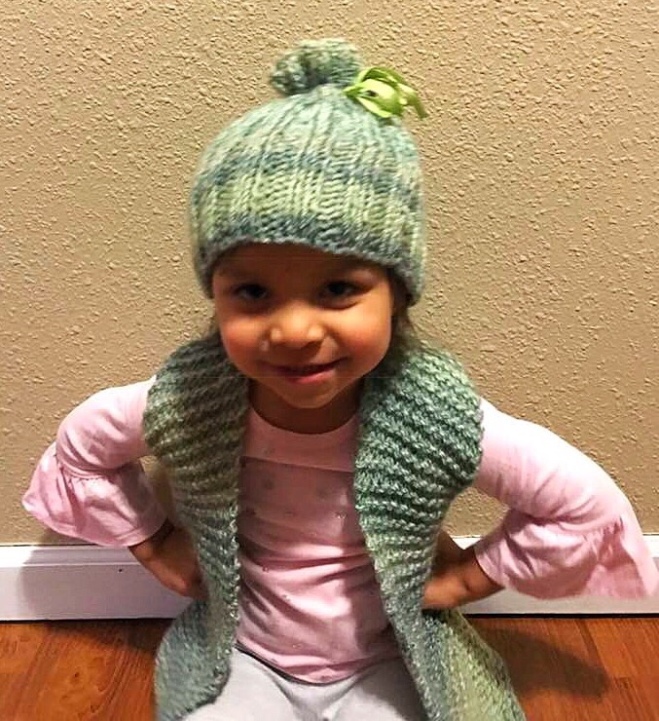
First day of Yupik immersion school in Kotzebue, Alaska (Niyah’s Yupik name is AVAQ)
Beautiful hand-made sweater and hat gifted by sisters from “knitting in recovery”❤Lise Solvang-sending back the love🌺

First day of Yupik immersion school in Kotzebue, Alaska (Niyah’s Yupik name is AVAQ)
Beautiful hand-made sweater and hat gifted by sisters from “knitting in recovery”❤Lise Solvang-sending back the love🌺
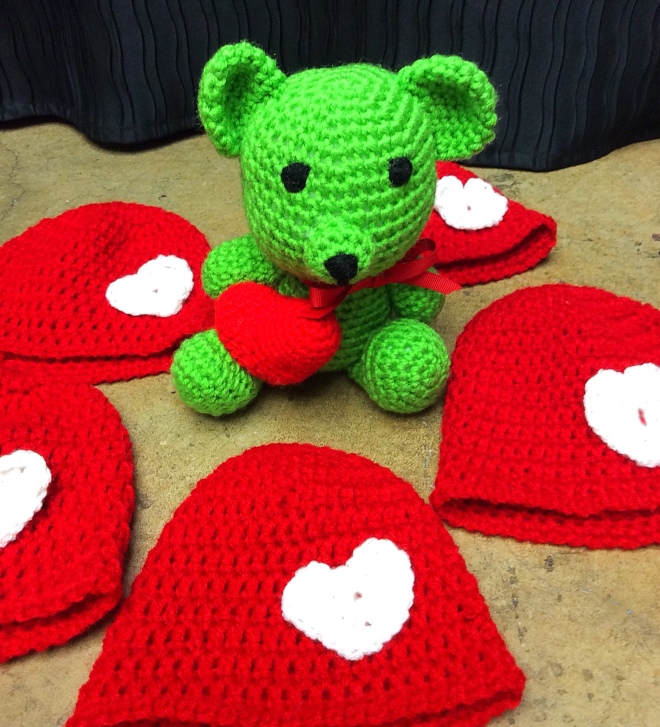
Love the Happiness Feel I get from Velya who crochets these adorable Valentines Bears and Ladonna who crochets these Valentines Beanies for homeless children. ❤️💚❤️
All We Knit Is Love❤️🙏❤️
Today we are spotlighting Ali! We first met Ali as a client at one of our Knitting in Recovery classes. Now Ali has been clean and sober for over a year, and she is one of our teachers for Knitting in Recovery!
Over the summer, Ali submitted several pieces to the Ventura County Fair and won three 3rd place, one 2nd place, and one 1st place ribbons!
Ali is currently teaching for Knitting in Recovery at one facility and will be starting at a few new facilities in the coming months. We are also hoping to start a knitting and crochet group at the VC Arts Collective in the Pacific View Mall, which Ali will teach.
Ali has several pieces on display and available for purchase at the VC Arts Collective, including several beanies slouchy beanies and adorable clutch purses.
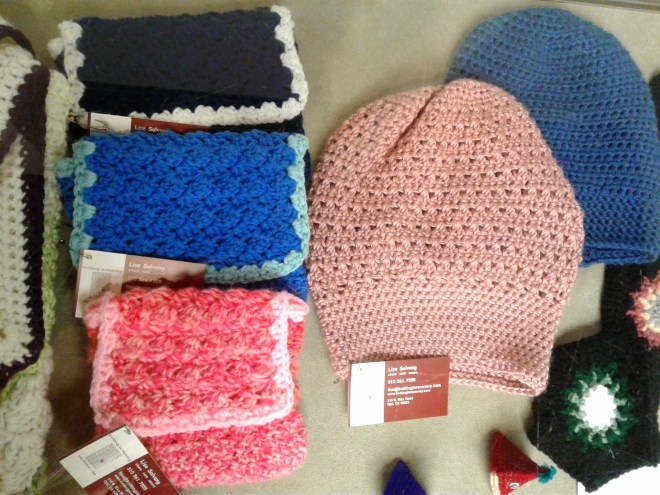
She has finished several recent commissions including leg warmers, beanies, and blankets, and she is currently working on a king-sized blanket for a family friend. She is already planning on making beanies in sports team and school colors to have for sale at the mall space, such as black and gold for Ventura High School.
Thank you, Ali, for helping our program grow and better serve our community.
Today we are spotlighting Deb Thompson.

Like many of us, Deb learned to knit from her mother when she was young. She mostly put her needles down until she walked into Anacapa Fine Yarns and was suddenly inspired to knit again! (Who can ever resist gorgeous yarn?!) Deb has also taken up weaving, in part as a means to use up scrap yarn, and has even ventured into spinning her own yarn. She is part of the Ventura Weavers and Spinners Guild.
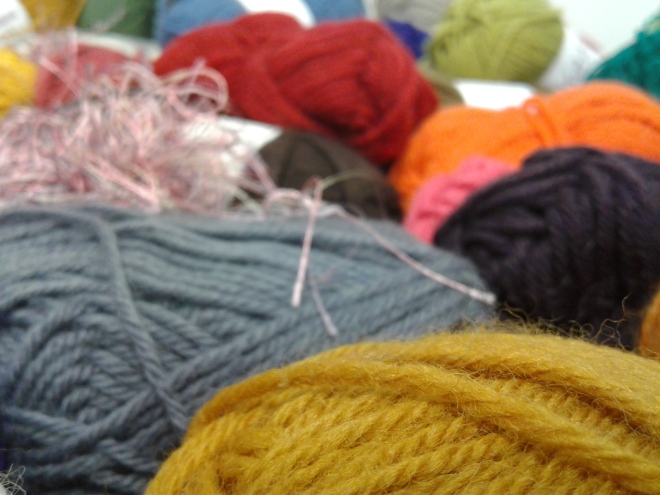
Deb made a generous donation of vibrant wool yarn, including some that she had spun herself. We are honored to receive this labor of love.
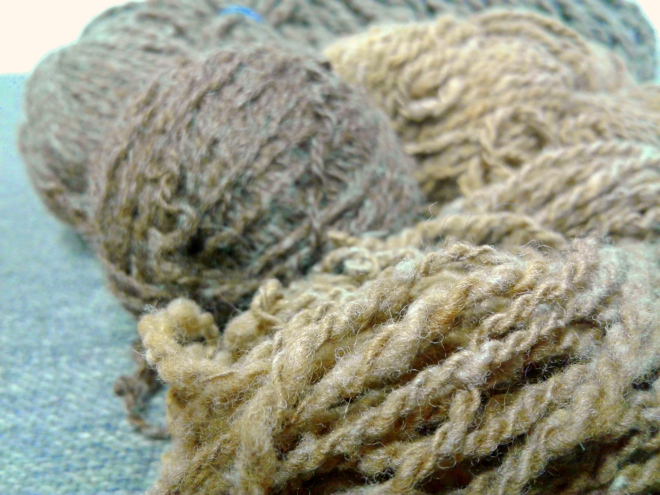
Thank you, Deb, for helping our program succeed in helping other women in our community.
Knitting in Recovery recently received a grant for Reentry through the Arts (RTA) from the California Arts Council (CAC).
Reentry Through the Arts is a new, two-year pilot grant program rooted in the California Arts Council’s belief that the arts are a powerful vehicle for positive change in people, communities and society. The grant supports high quality arts programs for people who have been convicted of a criminal offense and have served time in correctional institutions. The proposed grant project must have the arts as a central component of a holistic and integrated approach to reentry that also identifies other community-based support services including but not limited to job skills training, job placement, mental health and wellness, drug treatment, and/or case management.
Knitting in Recovery, in collaboration with the Ventura County Arts Council (VCAC), is using this grant to provide workforce training to one of our clients who is on probation and has been clean and sober for over a year. She lives with her infant son and is a talented crocheter. Now, she is able to serve others by teaching Knitting in Recovery classes at several of our facilities.
Through the grant, she is able to work at the VCAC Arts Collective in the Pacific View Mall. At the Arts Collective, she is learning customer service, inventory, point of sale, merchandising, event-planning, and other valuable workplace skills.
For over a year, Knitting in Recovery has partnered with the Ventura County Arts Council (VCAC), a non-profit that serves the whole of Ventura County with arts education and advocacy. VCAC runs a space in the Pacific View Mall called the VC Arts Collective. The space acts as part gallery, part retail space, and part art studio and classroom.
Knitting in Recovery is very excited to be featured in this space. Currently, we have a permanent display case full of work made by our clients. We also have some pieces hanging along the display wall including a fantastic granny-square blanket and small pom-pom wall-hanging. Our teachers and clients engage in workforce training and help to staff the space.

In the near future, we hope to establish knitting and crochet classes in the space and have an Arts in Recovery exhibition (including reception) including work from our knitting and crochet classes, visual art classes, and poetry classes taught at recovery centers.
We are excited about the opportunities the Arts Collective provides for our program and our clients. Many thanks to the Ventura County Arts Council for their collaboration.
The VC Arts Collective is located at:
The Pacific View Mall
3301 E Main St, Suite 2167
Ventura, CA 93003

Today we are spotlighting Celeste Matesevac, Marcia Doty, and BookEnds Bookstore. BookEnds has hosted our Worldwide Knit in Public Day celebrations for several years now and has also hosted a number of community scarf baskets. We asked Celeste and Marcia to share a little bit about themselves, the shop, and how they got involved with Knitting in Recovery. Thank you, Celeste, Marcia, and BookEnds, for helping our program succeed in helping other women in our community:
BookEnds Bookstore & Curiosities is located in Meiners Oaks, the unincorporated area just outside of Ojai. BookEnds is run by Marcia Doty and Celeste Matesevac. Marcia began selling Antiquarian Spiritual books years ago and always dreamed of having a bookstore in a church. Celeste had a career of working for non-profits in Ojai until retiring in 2017 from 14 years with the Search Dog Foundation of Santa Paula, CA. The pair have run several businesses together over the years, but this one is by far their favorite, as they love meeting new people and sharing not only their books but also the town’s incredible history.
BookEnds’ mission is to keep the printed word alive through our “lightly read” treasures of mainly non-fiction books. The bookstore is a literary escapade, as you can browse in the church/bookstore to discover the History of Ideas, Fine Arts, Children’s Literature and especially the Spiritual Traditions. Or go outside to Addendum 1, a retrofitted 1961 Airstream, to explore Travel, Adventure, the Great Outdoors. It’s a bookshop on wheels that stays in one place. Directly behind the Airstream is Addendum 2-Do, a homey hideaway tiny-house shed featuring Crafts, Hobbies, Gardening and inspired Everyday Living.
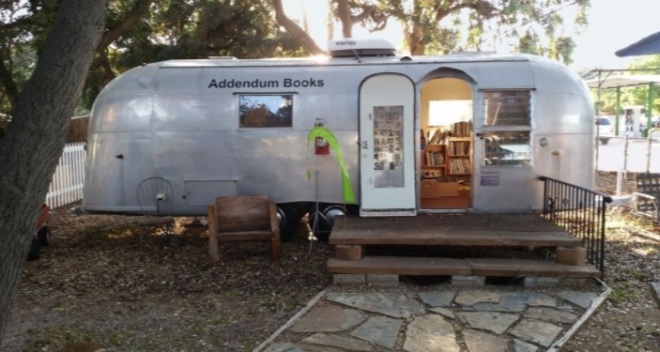
The shop also features vintage bookends throughout the store, vintage cameras, and has a case of Vaseline Glass for sale.
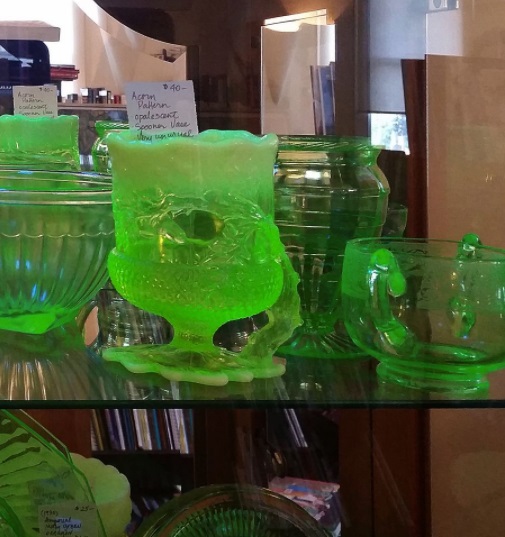
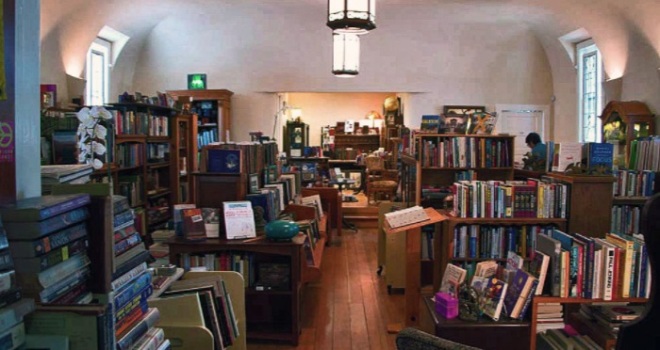

Today we are spotlighting Terri Nigro. Terri has given generous yarn donations that we have spotlighted in the past. Not only that, but she has gotten other friends involved in donating to Knitting in Recovery as well. We asked Terri to share a little bit about herself, her passion for knitting, and how she got involved with Knitting in Recovery. Thank you, Terri, for helping our program succeed in helping other women in our community:
I first learned to knit at a class at Sears when I was 10 years old. Our project was a sweater (yikes!) that I made for my mother (who, bless her heart, wore it underneath her winter coat on a few occasions). After that, I didn’t knit again until I was in my forties. I had, however, cross-stitched for many years and enjoyed it very much.One day, my cross-stitch friends went on a trip to a yarn store, and I went along. I saw so many pretty samples and beautiful yarns, and I caught the fever. I bought some fancy eyelash yarn that was all the rage and brought it home. I looked up knitting on the Internet, and re-taught myself to knit. I garter-stitched a scarf, and I was on my way with two new hobbies: knitting and collecting yarn. After 30 scarves, I started to branch out to other items and stitches. I’ve learned to do socks and sweaters and everything in between.I’m even better at that second hobby: stash-building. So when Lois at Anacapa Fine Yarns told me about Knitting in Recovery, I was pleased to be able to share a goodly sum of yarn to the project. I also let those knitting friends know, and Marsha Blanton, Janet Mailhot, Lou Webster, and JoAnn Zullo added to the bags as well.I’m grateful for all the good work happening at Knitting in Recovery, and that they are able to share this fun and creative hobby with those who find it brings them peace and a smile.-Terri

Today we are spotlighting Brenda. We asked her to share a little bit about herself, her passion for knitting, and how she got involved with Knitting in Recovery. What she wrote was honest, powerful, and touching. Thank you, Brenda, for helping our program succeed in helping other women in recovery:
Hi,
I am so flattered that you are interested in writing a blog post about me. But as I sit down to write about myself, I find it very difficult. But I’ll give it a shot.
I was born in a lovely small town on the southwestern shores of Lake Michigan. My mother married my father when she was 18 and he was 21. Due to infertility problems, I didn’t come along until 12 years later, which probably was for the best. Back then, women didn’t have much access to birth control and it wasn’t unusual to have 4 or more children closely spaced. Although that’s what my mother thought she wanted, she came to realize that my father was an emotionally and verbally abusive man, who also was a moderately-functioning alcoholic. Once I was born, she decided that we would be better without him and filed for divorce: a very brave thing to do in 1961. My father moved about 30 miles away, and although he continued to see me sporadically for the next couple of years, by the time I was three, he had a new family and stopped seeing me altogether. I received a few letters from him over the years with invitations to meet, but he never followed through. The last time I saw him was in a funeral home after he passed.
Although my mother’s family lived about 20 miles away, it was like another world, and one to which she did not want to return. Life was very tough in those early years, but the two of us made a nice little family. She always emphasized education, and I loved school. I was always very independent and felt that a good education was the means to a better life. For a while, life continued on a fairly normal path, and eventually I went to college in Chicago, a city that I love.
Aside from some pot smoking, I stuck to alcohol for partying. And honestly, I was a very moderate drinker with no signs of an addiction problem. In fact, I was the girl who stayed sober enough to watch out for drunk girlfriends or be the designated driver. But when I was 30, I broke up with a long-term boyfriend. I was completely devastated. It hurt so badly that I spent hours curled up in a ball crying. But worst of all, I couldn’t sleep. That’s when I bought my first bottle of scotch to “help” me sleep.
But it got bad very fast. I refer to the next seven years as “crawling into a bottle, and then trying to crawl out, often unsuccessfully.” I lost my job and my apartment and had to move back home. Like most recovery paths, there were several starts and stops. I did one inpatient rehab and several outpatient. After one stint, I was able to stay sober for 6 months. But I became arrogant and stopped going to meetings. I was finally called into Human Resources at my new job because someone smelled alcohol on my breath. I was given the opportunity to keep my job if I attended outpatient treatment. I accepted, but also made the decision at that moment to stay sober.
That was March 17, 1997. This time, I was successful because I truly embraced the first three steps for the first time in my recovery journey.
Life didn’t become perfect overnight, and in fact, I feel like I am still rebuilding from things I lost during those seven years. One thing that had continued to allude me was a career that I liked. Surprisingly to me and others (it’s a long story for another time), I obtained my Masters of Science in Accounting. I now work on a freelance basis, since my health keeps me from working full-time, or meeting the demands of a conventional accounting firm (more about that coming).
My knitting history is not uncommon. My mother learned to knit from one grandmother and to crochet from the other. She taught me to knit when I was young, and I knit a couple of scarves and quit. When I first began recovery, I spent a lot of time alone (aside from meetings and work), and I needed to keep my mind busy. I read a lot and also decided to try knitting again. This was the period when fun-fur scarves were popular. I discovered that I enjoyed it and wanted to branch out. This was when knitters were venturing into the internet (although a few years before Ravelry, a knitter’s dream website). I am not artistic, but love color. So many indie dyers were popping up with beautiful yarns, and I taught myself to knit socks.
It seems that the addictive part of my brain kicked in, although this time, it was yarn, especially sock yarn, that had replaced alcohol. I joined yarn clubs and felt an adrenalin rush when the boxes showed up in my mailbox. If I knit from now until eternity, I would never get through the stash I amassed.
In 2016, I was working furiously to finish a baby sweater for an upcoming family baby shower (Elizabeth Zimmerman’s baby surprise jacket which never disappoints), and I noticed my right hand becoming sore. At my age, I expect to have a little arthritis, so I wasn’t alarmed. But one morning, I woke up to find that my right hand was essentially frozen in one position. This scared me enough to go to the doctor. The diagnosis: rheumatoid arthritis (RA). If you aren’t familiar with RA, it’s actually not arthritis in the conventional sense, but instead, a chronic, incurable auto-immune disease in which one’s immune system attacks joints and organs. This was life-changing news, to say the least. And once again, I revisited Step #1: I am powerless over this disease, and if I don’t work a recovery program of some kind, my life will become unmanageable.
It’s been 18 months since my RA diagnosis, and although my hand is much better, I am still working hard to accept many of the physical limitations to my mind and body caused by the disease and medications. Luckily, I haven’t needed narcotics for pain, but I am aware that my addictive-prone brain may be all too happy to have access to mood-altering substances again in the future.
As I wrote, acceptance has been especially difficult for me. One day, I was looking at my yarn stash and finding myself drowning in self-pity for all the beautiful yarn that I would never use. But we in recovery know that self-pity is a dangerous emotion. At some point, several years ago, I had read about a woman who was teaching women in recovery to knit as part of their program. A few Google searches later, I found Knitting in Recovery. I was immediately heartened as I looked through your Facebook page and found photos, not only of women who were knitting and crocheting for themselves, but also for those who are less fortunate. As they say, deciding what to do with a great deal of my stash became a no-brainer. And before I knew it, my dear husband was lugging several boxes of yarn to the post office. I feel as though this was an appropriate way to work the 12th step.
It turns out that I am not yet finished with yarn. After several months, my hand became more flexible, and I have gone back to knitting, albeit, not as fast or as prolific. I’m more careful about choosing projects, and find that socks are too hard on my hands. Instead, I make fingerless mitts, which I wear almost constantly these days to keep my hands warm and more flexible. Plus, more people see the lovely yarns I’m using: win-win, right?
I continue to work my recovery, although I have found Al-Anon to be more helpful as I revisit step #4. It also helps me to understand, that, while my father was absent during my life, his alcoholism was still in the background, working its devious behavior on both my mother and me.
In closing, I will say that, while I can’t really say that I am happy that I became an alcoholic, I am nevertheless grateful to have become acquainted with the 12 steps. I think they are brilliant tools for living a good life. I also want to stress that I understand that I have not begun to face the hurdles that so many others in recovery have or continue to face. I meet people around the tables that remind me of this with every visit. I wish I could hug everyone and make it better. But perhaps you’re ladies will find a least a little happiness as you pick up knitting needles or a crochet hook, and create a lovely hat, scarf, or shawl that will give you a sense of accomplishment. Because we women are strong, and we deserve all the happiness life has to share.
Fondly,
Brenda
Thank you, Brenda!


